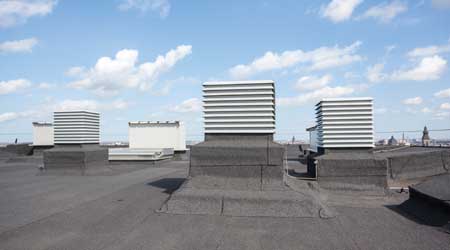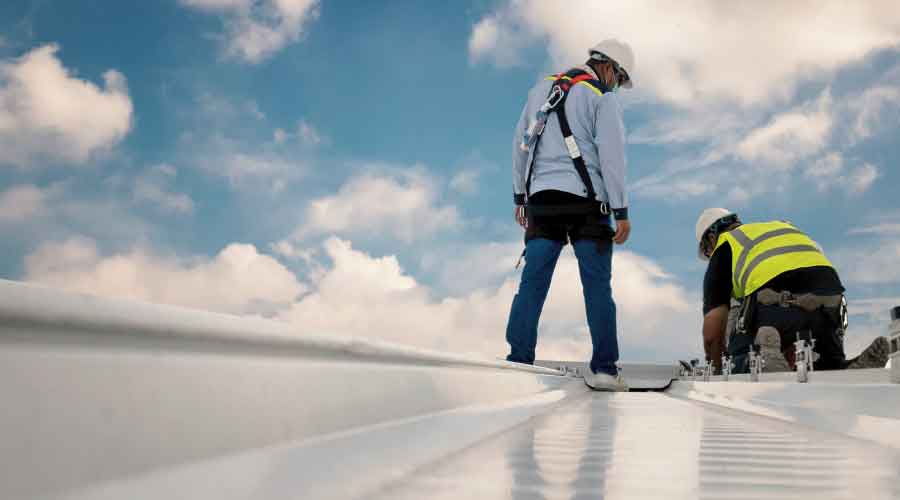 Replacing rooftop equipment, such as HVAC units, must be done carefully under close supervision to prevent damaging the newly installed roof.
Replacing rooftop equipment, such as HVAC units, must be done carefully under close supervision to prevent damaging the newly installed roof.Eye on Installation for Successful Roof Replacements
Close attention to roof specification, installation and maintenance can ensure long performance life for a valuable facility component
A new roof can be installed on top — an overlay — or the old roof can be removed before the new roof is installed — a tear-off. An overlay is less expensive but will not last as long as a tear-off because the base for the new roof is the old, unstable, worn out roof. Some roofers specialize in tear-offs and can easily remove even very large roofs in a day, including removal of old roofing from the job site and disposal. Because these two phases are so specialized, experts advise getting separate contractors for the tear-off and the installation for the best results.
Weather is the most challenging installation problem. If the existing roof is deteriorated and patched, then rain, snow and sleet already have been soaking the insulation, penetrating into the building and damaging assets. When the tear-off begins, managers need to be sure contractors take steps — for example, installing a 20- by 25-foot blue polyethylene tear resistant tarp covering exposed areas — to protect assets below the roof from weather damage during the installation. Part of the preparation is having enough of these tarps on hand before the replacement begins to cover expaosed areas.
Managers also must consider the time of year for the roof replacement. There have been cases in which a manager underestimated the time required for the planning, specification, evaluation, and deciding which proposal to accept, resulting in a late start in the fall or early winter.
Weather can be unpredictable. Forecasts can indicate mild weather when a manager decides to start the project, but when the tear-off is done, the weather turns nasty. Rain, sleet, snow, and ice have caused unplanned disasters, including forcing building occupants to move to another site, paying expensive transportation and rental until the roof project is complete.
Rather than fight the elements, managers can start planning the roof replacement in the summer before the installation is to be done. This is only possible if the manager keeps track of roof condition and is ready to begin the project anytime after the warranty expires. Usually, the warranty is for 15 years and is very conservative. A roof often lasts for years after the warranty expires. Still, if replacement planning starts before year 14 of the warranty, the owner gains a strategic advantage. It is always possible to move the start date forward, but it is not possible to back it up when it’s too late.
Every roof penetration presents a potential installation problem. Rooftop HVAC equipment, plumbing exhausts and elevator shaft vents all must be carefully sealed. Parapet caps also must be sloped onto the roof where proper drainage exists. Otherwise, the water runs off the parapet and drains down the side of the buildings causing discoloration, algae, mold buildup and, even worse, water intrusion through walls.
Many buildings have an accent band around the top composed of an exterior insulation and finishing system (EIFS). Several proprietary EIFS systems are available, but typically they consist of three layers: foam plastic expanded polystyrene insulation; a layer of reinforced fiberglass mesh embedded in cementitious adhesive; and an outer weather-resistant layer of troweled or sprayed-on colored, textured acrylic paint. Continuous drainage from a parapet cap that drains onto the wall can erode the two outer layers of EIFS and allow water penetration into the insulation and the building. The same erosion can cause brick mortar to leak.
Workers also should inspect vent stacks carefully. By the time of a roof replacement, many stacks have been in place for the 15-year life of the warranty or longer. Before placing new flashing around them, they must be inspected for signs of rust. This is the time to replace them. These stacks usually have a connection to the vertical riser inside of the building about 2 feet below the roof line. Replacing the 2-foot stack extension can ensure the stack will last a long time.
Careful sloping of the new roof surface is essential to ensure proper drainage. Ponding will occur at low spots where the roof surface dips below the scuppers and the water drains to downspouts. When water sits in these ponds more than a few days before drying, the combination of water and dirt, dust and other debris will shorten the roof life. The sun’s ultraviolet rays speeds up this process.
Related Topics:















